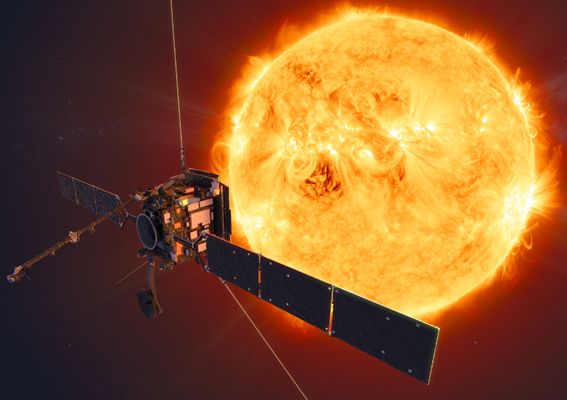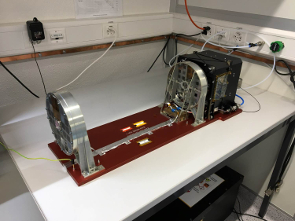10th February 2020
Enterprise Ireland client companies develop mission-critical technologies for ESA’s Solar Orbiter Spacecraft
The European Space Agency's (ESA) Solar Orbiter spacecraft successfully launched from Cape Canaveral, Florida earlier today. Its mission is to perform close-up observations of the Sun from high-latitudes, providing the first images of the uncharted polar regions of the Sun, and investigating the Sun-Earth connection.
On the spacecraft, Irish company ENBIO’s mission-critical thermal coating technology (SolarBlack) helps protect the spacecraft and its scientific instruments from the Sun’s intense radiation at this distance. In addition, Dublin-based software company CAPTEC provided Independent Software Verification & Validation (ISVV) services to ensure that Solar Orbiter’s critical onboard software is fit for purpose. Together, ENBIO and CAPTEC won a total of €3.1M in industrial contracts for the Solar Orbiter mission.
Furthermore, Trinity College Dublin and the Dublin Institute for Advanced Studies received ESA funding of €965k to support the development of imaging software for the STIX (Spectrometer/Telescope Imaging X-rays) instrument, one of ten science instruments onboard.
The spacecraft was built by prime contractor Airbus D&S (UK), with contributions from industries in ESA Member States. It carries a range of scientific instruments for in-situ measurements and high-resolution imaging of the Sun, provided separately by a consortium of Member States, including Ireland.
Ireland’s membership of the European Space Agency, funded by the Government through the Department of Business, Enterprise & Innovation, enables Irish industry and research institutes to participate in the development of technologies for ESA science missions such as Solar Orbiter.
Congratulating Irish companies ENBIO and CAPTEC following the successful launch of the Solar Orbiter mission yesterday, Minister for Training, Skills, Innovation, Research & Development, John Halligan, said “ENBIO and CAPTEC are among a rising number of innovative Irish SMEs developing mission-critical technologies through ESA’s science programme, and that have commercial applications back here on Earth. I warmly commend both companies for their contribution to the Solar Orbiter mission, and wish the European Space Agency every success at the start of this challenging journey to the Sun.”
Solar Orbiter is a European Space Agency (ESA) mission with strong NASA participation, selected as the first medium-class mission of ESA's Cosmic Vision 2015-2025 Programme.
Solar Orbiter aims to make significant breakthroughs in our understanding both of how the Sun’s heliosphere works, and of the effects of solar activity on it. The spacecraft will take a unique combination of measurements: in-situ measurements will be used alongside remote sensing close to the Sun to relate these measurements back to their source regions and structures on the Sun's surface, watching for magnetic activity building up in the atmosphere that can lead to powerful solar flares and eruptions.
Dr Tom Kelly, Director of Innovation & Competitiveness at Enterprise Ireland said “ENBIO’s novel thermal coating will help protect the spacecraft and its scientific instruments from intense solar radiation – effectively acting as a ‘sunscreen’ for the spacecraft. In addition, CAPTEC played a crucial role in assuring that the onboard software will function reliably over the mission’s lifetime.”
Dr Kelly also noted “Ireland recently published National Space Strategy for Enterprise 2019-2025, which focusses on creating sustainable space-active businesses developing ground-breaking technologies for space and spinning out those technologies into commercial terrestrial markets including automotive, medical, advanced manufacturing and fintech. ENBIO’s novel coating technology has already been applied in rubber moulding applications, while CAPTEC are applying software techniques they utilise for spacecraft to banking and medical sectors.”
ENDS
Notes to Editor:
About Solar Orbiter
More details of the mission can be found on ESA’s website here:
esa.int/Science_Exploration/Space_Science/Solar_Orbiter
esamultimedia.esa.int/multimedia/publications/BR-345/BR345.pdf
Irish Industrial & Research Contributions
Two Irish companies have made significant technical contributions to the Solar Orbiter mission:
At closest approach, Solar Orbiter will be approximately 42 million kilometres from the Sun (or just over a quarter of the distance between the star and our planet). ENBIO’s mission-critical thermal coating technology (SolarBlack) helps protect the spacecraft and its scientific instruments from the Sun’s intense radiation at this distance. SolarBlack is a calcium phosphate preparation applied to the outermost layer of Solar Orbiter’s heatshield, helping it withstand temperatures of up to 500°C. The coating is also applied to the High Gain Antenna, favoured for this mission because it can maintain the same thermo-optical properties despite years of exposure to unfiltered sunlight and ultraviolet radiation.
Dublin-based software company CAPTEC provided Independent Software Verification & Validation (ISVV) services to ensure that Solar Orbiter’s critical onboard software is fit for purpose. The company has several decades’ experience in developing software for ESA missions, also applying these methods to other industries including banking, medical and manufacturing.
Irish Research Contribution
Prof Peter Gallagher (Dublin Institute of Advanced Studies, formerly of Trinity College Dublin) is a Co-Investigator on the Swiss-led consortium for the STIX (Spectrometer/Telescope Imaging X-rays) instrument. STIX will detect X-ray emissions coming from the Sun, which could be from hot plasma, often related to explosive magnetic activity such as solar flares. STIX will provide the timing, location, intensity, and energy data for these events so that their effects on the solar wind can be better understood.
Prof Gallagher and his team at DIAS are responsible for developing the STIX instrument’s data processing and analysis software. This work is supported by the Irish Government through ESA’s PRODEX programme, which funds the development of scientific instruments and experiments for ESA missions.
Enterprise Ireland’s Role
Enterprise Ireland coordinates both Ireland’s industrial and research participation in the programmes of the European Space Agency. Enterprise Ireland’s role is to assist Irish companies to successfully bid for ESA contracts. EI provides a source of expertise for Irish companies in developing and executing space strategies, as well as being a point of reference for the international space industry when they want to identify relevant sources of space-related expertise within Ireland.
There are currently 70 Irish companies active in ESA programmes, with 5 new companies engaging every year on average. Ireland contributes approximately €6M per annum to ESA’s mandatory Science programme, resulting in opportunities for Irish industry to develop innovative technologies for ESA science missions such as Solar Orbiter.
Irish companies ENBIO and CAPTEC won a total of €3.1M in industrial contracts for the Solar Orbiter mission. Furthermore, TCD received ESA PRODEX funding of €965k to support the development of imaging software for the STIX instrument. In addition, a number of Irish companies provided discrete high reliability electronic components to the spacecraft prime contractor.
Appendix: Images and Video

Artist’s impression of Solar Orbiter. © ESA / ATG media lab.
esa.int/ESA_Multimedia/Images/2019/10/Solar_Orbiter#.XiGMBRoxNI8.link

The Solar Orbiter spacecraft showing the scientific instruments. © ESA / ATG media lab.
esa.int/ESA_Multimedia/Images/2019/10/Solar_Orbiter_instruments#.Xh3SOsgszck.link

Infrared image of the Solar Orbiter spacecraft undergoing thermal-vacuum testing. The yellow colour indicates the high temperature (~520°C) of the heat shield, with ENBIO’s “SolarBlack” coating applied to its surface. © Airbus Defence and Space/IABG.
esa.int/ESA_Multimedia/Images/2019/04/Solar_Orbiter_during_thermal-vacuum_tests#.Xh3aGGTnjac.link

Part of the Solar Orbiter Spectrometer/Telescope for Imaging X-rays (STIX). © PSI.
sci.esa.int/web/prodex/-/59648-programme-introduction
Note: Photo Library for Professionals available here, if the photos above are not of sufficient resolution: esa-photolibrary.com
Video: esa.int/ESA_Multimedia/Videos/2019/12/Solar_Orbiter_boom_and_antenna_deployments#.Xh3mofT_0lY.link
Visualisation showing the deployment of various boom/antennas on the Solar Orbiter spacecraft. © ESA / ATG media lab.
Note: Videos for Professionals available here: esa.int/esatv/Videos_for_Professionals
ENDS
The Department of Business, Enterprise and Innovation (DBEI) plays a key role in implementing the Government’s policies of stimulating the productive capacity of the economy and creating an environment which supports job creation and maintenance. The Department has lead responsibility for Irish policy on global trade and inward investment and a remit to promote fair competition in the marketplace, protect consumers and safeguard workers.
For further information please contact Press Office, D/Business, Enterprise and Innovation, press.office@dbei.gov.ie or (01) 631 2200.
If you no longer wish to receive emails from the Department of Business Enterprise and Innovation Press Office, please notify us by email to press.office@dbei.gov.ie.
Back to Department News